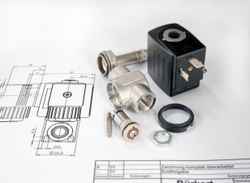
Posted to News on 19th Jan 2015, 09:56
Solenoid valves - an enduring design refined over time
The humble solenoid has been with us since the early 1900s, and since its invention it has seen a number of developments that have enabled it to provide control over a wide range of applications. From water and gas handling to hygienic and micro fluidic applications, each has its own challenges that have led to a range of designs for the mechanism and the coils. Paul Trevitt, Operations & Engineering Manager for Brkert UK & Ireland, looks at the improvements in design that have allowed an increasing number of processes to rely on this essential device.

Solenoid valves are the most frequently used control elements in fluidics. Their role can be to shut-off, release, dose, distribute or mix fluids or gases, all of which can pose a wide range of requirements and environments that must be accommodated in order to deliver reliable and effective service.
The first major step forward in solenoid design came in the 1950s when Brkert developed the first plastic-moulded body solenoid valves. Chemically resistive encapsulation protects the electrical system from harmful influences such as dust, dirt and moisture. This was followed by a universal modular valve system, which has been adopted by industry and allows the most efficient use of space when constructing more complex installations.
Over 90 per cent of all solenoid valves are equipped with single coils, the simplest of all coil types, which uses an enamelled copper wire wound on a coil form. These coils are designed for continuous operation and are usually coated with an insulating mass to ensure high electrical and mechanical protection. For applications involving ambient temperatures up to 250degC, it is important to ensure that the coils can withstand these conditions and so anodised enamelled copper wires may be used to ensure reliable operation.
Development of the basic design principles has led to reduced energy consumption with the introduction of the direct acting double coil design. This uses two independent windings with high and low power. The high-power coil opens the valve and then integrated electronics switch over to the low-power coil to provide the holding force. This twin coil approach provides sufficient power to open the valve, but then uses 75 per cent less power to hold the valve in position.
The design of the coil and its operation has a direct effect on the performance of the valve. The latest energy saving designs, even in single coil conventional formats, can allow the coil to be overexcited to open the valve and within half a second, the current is reduced by 95 per cent, which is still sufficient to hold the valve in the open position. The cumulative effect of this type of feature can have a significant impact on the energy required for process control.
Valve anatomy
Essentially solenoid valves are split between two designs, direct acting and pilot-operated. The former relies solely on the power of the magnetic coil to make or break the seal with the seat of the valve. In normally closed (NC) configurations, the coil is energised and the valve opens until the voltage is removed and the spring pressure closes the valve. The pressure and flow capabilities of these valves are determined by the power of the solenoid.
A pilot-operated solenoid valve uses the pressure differential between the inlet and the outlet to assist the solenoid coil and spring in opening and closing the valve. This design concept can be applied to various styles of solenoid valve in order to accommodate a wide range of applications where higher pressures and flows are required.
The type of solenoid valve most appropriate for each application is governed by a number of factors. Many of the solenoid valve components, such as the plunger, return spring and seals are all exposed to the media and therefore information on the chemical compounds, temperature and pressure are all necessary to make an informed material selection.
In the case of solenoid valve design, the general rule-of-thumb is: Plunger-type direct acting solenoid valves are best suited to neutral and clean fluids, while pivoted armature solenoid valves employ a media-separating membrane and are therefore suitable for controlling corrosive, contaminated or aggressive fluids.
If the production process involves liquid food products, the plastics and elastomers used should also conform to the local food and hygiene regulations. In addition, some processes require a cleaning cycle to be performed in between production processes and so the data is also required for this procedure as well to ensure there is no undue material degradation caused by steam or cleansing chemicals.
Design choices determine reliability
On the face of it, selecting a solenoid valve appears to be a simple enough decision; however, making the right choice requires an in-depth knowledge of the process under control as well as expertise in the materials and designs available. By combining the knowledge of the process engineer with the fluid control experience of Brkert, customers can be assured of a high-quality product that will deliver long-term reliability while also complying with the appropriate industry standards.
Brkert not only designs a comprehensive range of solenoid valves to cover both standard and specialist applications, it also manufactures every component which includes the machining of the valve body, the injection moulding of the coil body and the manufacture of the coil itself. In this way, Brkert has control over every aspect of the valve and so can guarantee its performance. Please visit www.burkert.co.uk for more information.
Fluid Control Centre
1 Bridge End
GL7 1QY
UNITED KINGDOM
+44 (0)1285 648720






























